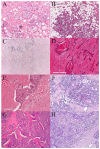Triple-Negative Breast Cancer Histological Subtypes with a Favourable Prognosis
- PMID: 34830849
- PMCID: PMC8616217
- DOI: 10.3390/cancers13225694
Triple-Negative Breast Cancer Histological Subtypes with a Favourable Prognosis
Abstract
Triple-negative breast cancers (TNBC), as a group of tumours, have a worse prognosis than stage-matched non-TNBC and lack the benefits of routinely available targeted therapy. However, TNBC is a heterogeneous group of neoplasms, which includes some special type carcinomas with a relatively indolent course. This review on behalf of the European Working Group for Breast Screening Pathology reviews the literature on the special histological types of BC that are reported to have a triple negative phenotype and indolent behaviour. These include adenoid cystic carcinoma of classical type, low-grade adenosquamous carcinoma, fibromatosis-like metaplastic carcinoma, low-grade mucoepidermoid carcinoma, secretory carcinoma, acinic cell carcinoma, and tall cell carcinoma with reversed polarity. The pathological and known molecular features as well as clinical data including treatment and prognosis of these special TNBC subtypes are summarised and it is concluded that many patients with these rare TNBC pure subtypes are unlikely to benefit from systemic chemotherapy. A consensus statement of the working group relating to the multidisciplinary approach and treatment of these rare tumour types concludes the review.
Keywords: acinic cell carcinoma; adenoid cystic carcinoma; fibromatosis like metaplastic carcinoma; low-grade adenosquamous carcinoma; mucoepidermoid carcinoma; secretory carcinoma; tall cell carcinoma with reversed polarity; triple negative breast cancer.
Conflict of interest statement
The authors declare no conflict of interest.
Figures

References
-
- Sorlie T., Perou C.M., Tibshirani R., Aas T., Geisler S., Johnsen H., Hastie T., Eisen M.B., van de Rijn M., Jeffrey S.S., et al. Gene expression patterns of breast carcinomas distinguish tumor subclasses with clinical implications. Proc. Natl. Acad. Sci. USA. 2001;98:10869–10874. doi: 10.1073/pnas.191367098. - DOI - PMC - PubMed
-
- Sorlie T., Tibshirani R., Parker J., Hastie T., Marron J.S., Nobel A., Deng S., Johnsen H., Pesich R., Geisler S., et al. Repeated observation of breast tumor subtypes in independent gene expression data sets. Proc. Natl. Acad. Sci. USA. 2003;100:8418–8423. doi: 10.1073/pnas.0932692100. - DOI - PMC - PubMed
-
- Badve S., Dabbs D.J., Schnitt S.J., Baehner F.L., Decker T., Eusebi V., Fox S.B., Ichihara S., Jacquemier J., Lakhani S.R., et al. Basal-like and triple-negative breast cancers: A critical review with an emphasis on the implications for pathologists and oncologists. Mod. Pathol. 2011;24:157–167. doi: 10.1038/modpathol.2010.200. - DOI - PubMed
Publication types
LinkOut - more resources
Full Text Sources

